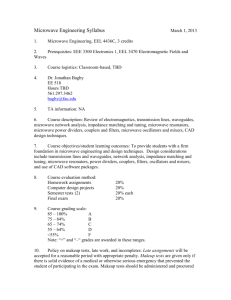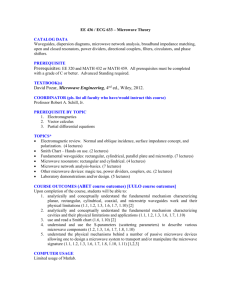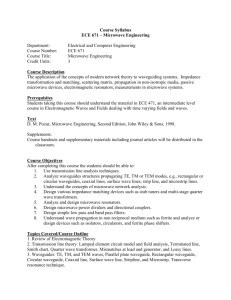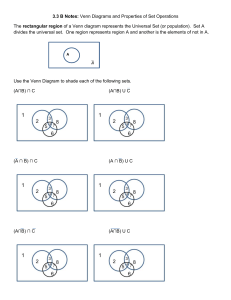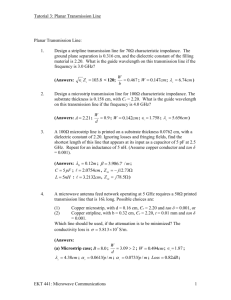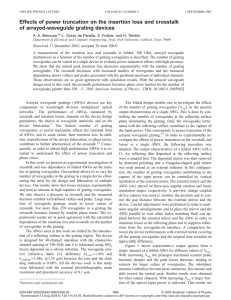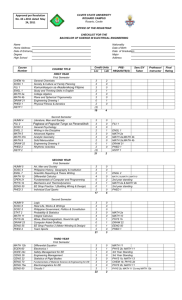EENG432_CD (3)
advertisement
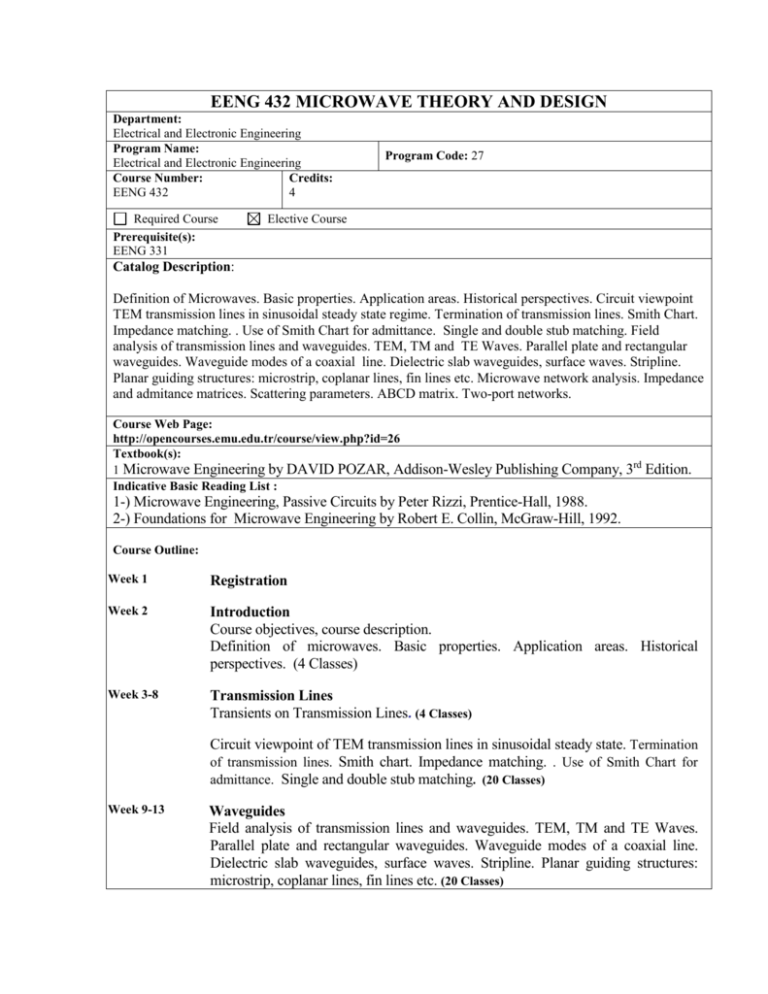
EENG 432 MICROWAVE THEORY AND DESIGN Department: Electrical and Electronic Engineering Program Name: Electrical and Electronic Engineering Course Number: Credits: EENG 432 4 Required Course Prerequisite(s): EENG 331 Program Code: 27 Elective Course Catalog Description: Definition of Microwaves. Basic properties. Application areas. Historical perspectives. Circuit viewpoint TEM transmission lines in sinusoidal steady state regime. Termination of transmission lines. Smith Chart. Impedance matching. . Use of Smith Chart for admittance. Single and double stub matching. Field analysis of transmission lines and waveguides. TEM, TM and TE Waves. Parallel plate and rectangular waveguides. Waveguide modes of a coaxial line. Dielectric slab waveguides, surface waves. Stripline. Planar guiding structures: microstrip, coplanar lines, fin lines etc. Microwave network analysis. Impedance and admitance matrices. Scattering parameters. ABCD matrix. Two-port networks. Course Web Page: http://opencourses.emu.edu.tr/course/view.php?id=26 Textbook(s): 1 Microwave Engineering by DAVID POZAR, Addison-Wesley Publishing Company, 3rd Edition. Indicative Basic Reading List : 1-) Microwave Engineering, Passive Circuits by Peter Rizzi, Prentice-Hall, 1988. 2-) Foundations for Microwave Engineering by Robert E. Collin, McGraw-Hill, 1992. Course Outline: Week 1 Registration Week 2 Introduction Course objectives, course description. Definition of microwaves. Basic properties. Application areas. Historical perspectives. (4 Classes) Week 3-8 Transmission Lines Transients on Transmission Lines. (4 Classes) Circuit viewpoint of TEM transmission lines in sinusoidal steady state. Termination of transmission lines. Smith chart. Impedance matching. . Use of Smith Chart for admittance. Single and double stub matching. (20 Classes) Week 9-13 Waveguides Field analysis of transmission lines and waveguides. TEM, TM and TE Waves. Parallel plate and rectangular waveguides. Waveguide modes of a coaxial line. Dielectric slab waveguides, surface waves. Stripline. Planar guiding structures: microstrip, coplanar lines, fin lines etc. (20 Classes) Week 14-16 Microwave Networks Microwave network analysis. Impedance and admittance matrices. Scattering parameters. ABCD matrix. Two-port networks. ( 12 Classes) Course Learning Outcomes: a) On successful completion of this course, the students will be able to: understand the basic properties and application areas of microwaves, analyse the the transmission lines, analyse the waveguides, analyse the microwave networks. On successful completion of this course, all students will have developed their skills in: b) understanding the microwaves and analysing the microwave networks. Class Schedule: Tutorial Schedule: 4 hrs of lectures per week Assessment Method Midterm Exam(s) Lab Homeworks Final Examination 1 hr of tutorial per week No 1 2 5 1 Percentage 35% 15% 10% 40% NG Policy: Any student who has an overall failing grade, and who has failed to attend the lectures regularly (min 80%) will be given the NG grade. Make-Up Policy: Students missing an examination should provide a valid excuse within three days following the examination they missed. No separate make-up exams are administered for midterm and final exams. Re-sit examination are administered as make-up examinations, instead. Contribution of Course to Criterion 5 Credit Hours for: Mathematics & Basic Science : 0 Engineering Design : 4 General Education : 0 Relationship of Course to Program Outcomes The course has been designed to contribute to the following program outcomes: (a) An ability to apply knowledge of mathematics, science, and engineering (b) An ability to design and conduct experiments, as well as to analyze and interpret data (c) An ability to design a system, component , or process to meet desired needs within realistic constraints (e) An ability to identify , formulate and solve engineering problems (i) A recognition of the need for, and an ability to engage in life-long learning (k) An ability to use the techniques, skills, and modern engineering tools necessary for engineering practice. Prepared by: Abdullah Y. Öztoprak Date Prepared: 2 October 2015
